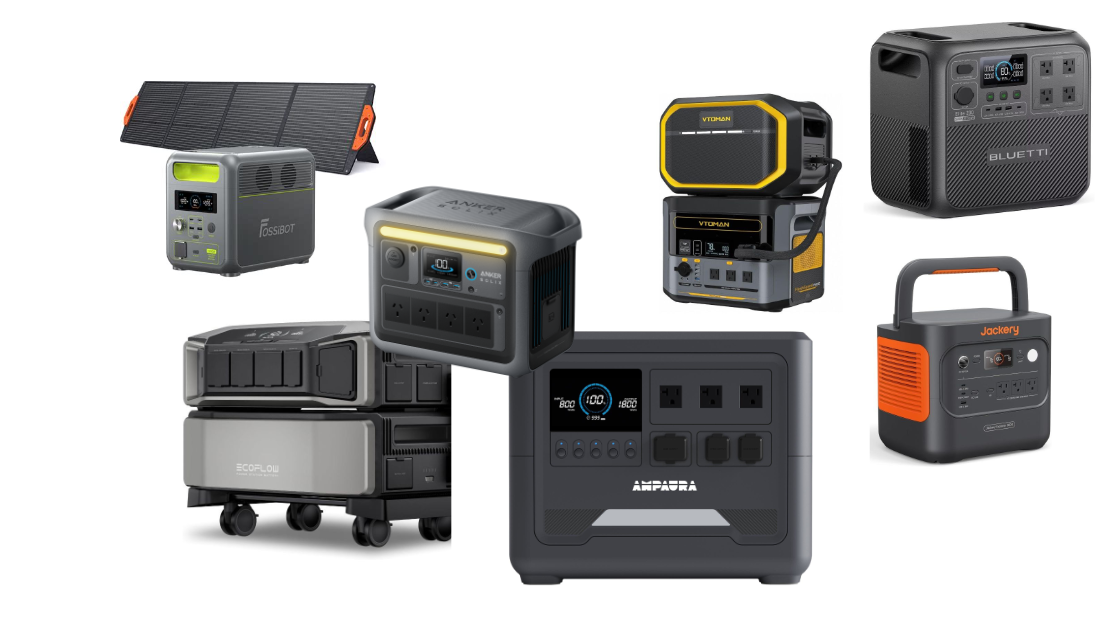Kilowatt Batteries. OMG!
Sophisticated and useful energy-dense "personal power stations" have quietly come to market. They are impressive.

2014: End of the "Real Goods" era
For years, people had fooled around with self-generated power and batteries. A few had off-grid homes or cabins. Many had boats or RVs that stayed at sea or in the wilderness for long periods of time. Even more people had remote or unusual applications—such things as powered farm gates, dugout water aeration setups, or wildlife cameras.
If they did the installations themselves, they all experimented with different ways of storing, using, converting, monitoring, and charging off-grid power. Solar panels. Wind generators. Fuel cells. Inverters. Golf-cart batteries. Intelligent chargers. Monitoring panels. I remember one converted power-boat trailer festooned with solar panels and weighted down with golf-cart batteries and inverters. It had been specially-constructed to operate power tools at remote, off-grid sites. It never did work all that well, mostly because you can't draw down too far on traditional batteries before they get messed up.
Even so, many of these experimenters had a lot of fun figuring out how to wire all this together. Were the voltages right? Did the inverter offer true, properly-phased AC power, or was it going to make a mess of your desktop computer? What would happen if you put your tongue on that bare wire? OK, nobody actually asked THAT question, but it's a fitting metaphor for the slightly under-engineered explorations that characterized many off-grid power installations of the day.
Just have a look at the final edition of the Real Goods Solar Living Sourcebook from 2014.1 Published before affordable solar panels, modern micro-inverters, lithium batteries, and smart monitoring, it could have easily been called "Electric Cowboy Country." It was the cookbook that most do-it-yourself off-gridders lived by. And swore at. (Doing it yourself was hard work, not for the faint of wits.)
2025: Personal power stations
Not all personal power stations are great, but some are absolutely impressive, especially when compared with the effort and risk of 2014.
Dozens of choices are on the market, but they all centre around a very capable lithium battery pack of at least 1 kilowatt-hour. And, of course, lithium batteries don't have the discharge limitations that impair lead-acid batteries: you can use almost all the power in them. In particular, new safety features—to protect your devices and the battery itself—are wonderful.
In the same chassis, all nicely integrated, you get (depending on who the vendor is and what you buy):
- Outlets for USB-C and USB-A
- A true sine-wave inverter that can power multiple 120V devices
- 12V automotive-style outlet
- A built-in light
- Charging connectors for solar panels and automobile DC voltage (and, indirectly, for fuel cells and wind generators)
- A charge controller for those same power sources
- A 120V input that can fast-charge the device at high rates (up to 1500 watts)
- RV ports
- A great little console showing how much power is going out and how much is coming in
- Bluetooth or Wi-Fi integration so you can monitor and control everything from your phone
- Built-in over-current protection, both for the battery and for all the AC and DC devices plugged into it
- A 120V plug that also acts as a surge protector and uninterruptable power supply (ideal for computers and monitors)
- An expansion port that lets you daisy-chain in more storage capacity
- Ability to scale everything up by adding more outlets and batteries
- A fantastic discharge rate (we have seen them with discharge rates up to 2,000 watts) that allows you to run actual appliances like coffee makers and toaster ovens
- Built-in surge power/headroom that often handles startup surges well above output ratings (be careful with this one: here's where research is important, but some personal power stations can handle brief surges of up to four times their discharge rates)
Many of the manufacturers of these personal power stations also make purpose-built generation accessories. For example, you can buy 600-watt folding solar panels that plug right in to the built-in charge controller.
Interestingly, the manufacturers of these devices are sort of shyly "backing into" the whole-house market. Their smaller products are marketed as camping devices, worksite aids, and auxiliary cell phone batteries (these smaller products, by the way, are remarkable too, and worth a separate article).
Larger personal power stations are often paired with solar and wind plug-and-play power sources. They are marketed as "generators" that compete with internal combustion emergency-power generators. And a few vendors offer large, blown-out versions meant for the utility rooms of houses that are either grid defectors or new off-grid buildings. At the moment, these installs are commonly positioned as "whole home support."
As you might expect, the larger of these installs are "reaching up-market" a bit and are probably much-too-expensive solutions for most homes, but vendors are cautiously approaching the whole-house market, tentatively exploring it. Offerings will certainly improve and become more economical. Stronger, more-competitive, whole-house plug-and-play offerings would not be a surprise at all.
In the meantime, with a little kilowatt unit, you can have a heck of a good time in your tent.
Semi-Disclosure: We have a couple of these and love them, but we're not telling you which ones we've bought. Instead, you should go to a search engine and look for reviews.
Reading
- Schaeffer, John. Real Goods Solar Living Sourcebook: Your Complete Guide to Living beyond the Grid with Renewable Energy Technologies and Sustainable Living. 14th ed. Gabriola Island, BC: New Society Publishers, 2014.
- Images for the montage were drawn from these manufacturer websites:
We don't imply any endorsement here. The images and links are for illustration only, chosen randomly from search-engine results.
